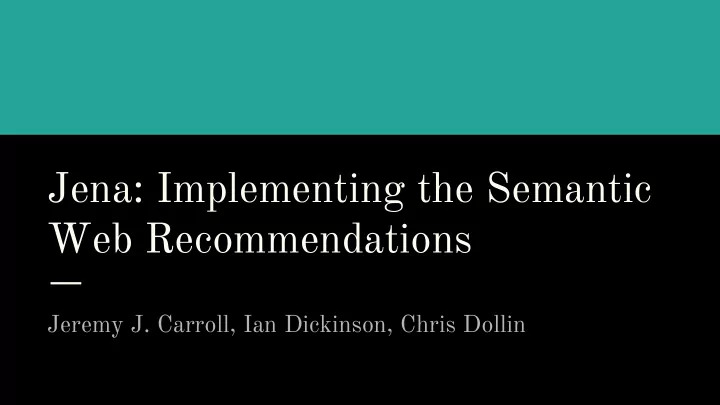

Jena: Implementing the Semantic Web Recommendations Jeremy J. Carroll, Ian Dickinson, Chris Dollin
Introduction
● RDF = Resource Description Framework ● OWL = Web Ontology Language ● Both together form a standardization for a simple triple-based representation of knowledge. ● RDF triple is <s, p, o> ● Jena is a Semantic Web Toolkit. ○ It has a graph as its core interface. ○ It provides rich API for dealing with RDF. ○ It supports RDQL (RDF Data Query Language). ● RDFS and OWL provide the vocabulary, schema and ontology.
Architecture Overview
● Jena architecture is mainly composed of three layers ● The Graph Layer: ○ It is based on RDF (set of triples of nodes). ○ It has a triple store (in-memory, persistent). ○ It has virtual triples resulting from inference on other triples. ● The Model Layer: ○ It is the abstraction of the RDF graph that is used by application programmers. The EnhGraph Layer: ● ○ It is the intermediate layer between Graph and Model layers. ○ It provides views for the graph and nodes.
Graph Layer
The Graph Layer ● Graph is composed of triples <Subject, Predicate, Object>. ● A triple’s node represents RDF URI label, a blank node (bNode which is an anonymous resource), or a literal. ○ <Michael, studiesAt, UW> The restriction that a literal can only appear as an object and a property must ● be URI are forced by Model Layer not Graph Layer. ● Graph interface supports modifications (add, delete) and access (list all triples). ● find(Node s, Node P, Node O) returns an iterator on all triples matching <s,p,o>.
Fast Path Query ● Each graph has a query handler that manages complex queries. ● It implements complex query in terms of “find” primitive. ● Query consists of triples patterns to be matched against graphs. ● Ex: (?x P ?y) (?y Q ?z) ○ All possible bindings of the variables are returned. ● Jena’s memory-based Graph model implements this query by simply iterating over the graph using “find”. ● RDB-based graphs can alternatively compile queries into SQL to get the results from DB-engine.
Model Layer
APIs ● Graph layer only provides triples. ● This is not easy to work with within the application level. ● The Model layer has an API that acts as the presentation layer over graph. ● Resource is an abstraction corresponding to rdfs:resource . ○ It is represented as a URIref or bNode ○ It provides a view to a collection of facts about the node ● Ex: a URIref having a type rdf:Bag provides a view on the node that allows access to specific triples related to it.
Enhanced Graph Layer
Presentation Layers and Personalities Polymorphism ● ● Each presentation layer has: RDFS permits resources to have ○ Interfaces multiple types ( rdfs:SubClassOf ) ○ Implementation classes which acts as multiple-inheritance. ○ ● Mapping from interfaces to Java objects can only have one class. ● methods invoking the classes Given a Node (EnhNode) and ( Personality ) personality it is possible to create a ● Implementation classes extends view. EnhGraph or EnhNode ○ EnhGraph is a wrapper around Graph with a pointer to personality ○ EnhNode is a wrapper around Node with a pointer to EnhGraph
Inference Support
● Inference engines consist of reasoners (Graph combinators): ○ Combine RDF Graphs (ontology - instances) ○ Expose entailments as another RDF Graph ○ Virtual entailments rather than materialized data ● It enables stacking reasoners after each others (flexibility). ● RDQL queries can be applied to inferred graphs. ● External reasoners are easily registered into the system.
RDQl-RDF Query
● RDQL = RDF Data Query Language ● RDQL query consists of a graph pattern (list of triple patterns) ○ pattern : URIs and named variables (?x) ○ constraints on values of variables ● RDQL can include virtual triples ● No distinction between: ○ Ground triples ○ Virtual triples
Persistent Storage
● Persistency is supported by using a conventional database. ● Each triple is stored in a general-purpose triple table or property table. ● Jena uses a denormalized schema: ○ URIs, literals are stored directly in the triple table. ○ Separate literals table is used for storing large literals. ○ This enables the processing of many queries without using join. ○ It trades off time with space (more space for denormalization). ● Common namespaces prefix in URIs are stored in a separate table. ● Property tables: ○ They hold statements for a specific property. ○ They are stored as subject-value pairs. ○ Property table and triple table are disjoint (triple is stored once). ○ Property class table stores properties associated with a particular class with all of its instances.
● Queries are executed on graphs that can span multiple statement tables. ● Each statement table has a handler to convert between Jena graph view and the SQL tuple view. ● The query processor passes the triple pattern to each table handler for evaluation. ● Jena supports fast path query with a goal to use the database engine to process the entire query instead of single patterns. ○ Case one: all triple patterns access only triple table. ○ Case two: all triple patterns can be evaluated on a single property table.
Joseki
● Joseki is a webAPI for Jena. ● It provides a remote API that is simple to use. ● Access mechanism is graph-based query where the target is a remote knowledge base and the result is a graph. ● Client does not know what happens on the server. They just communicates through queries and expect results. ● A host repository can have different graphs. ● The webAPI requires each graph to have a different URL. ● HTTP is used as the protocol for querying the RDF.
Thanks
Recommend
More recommend